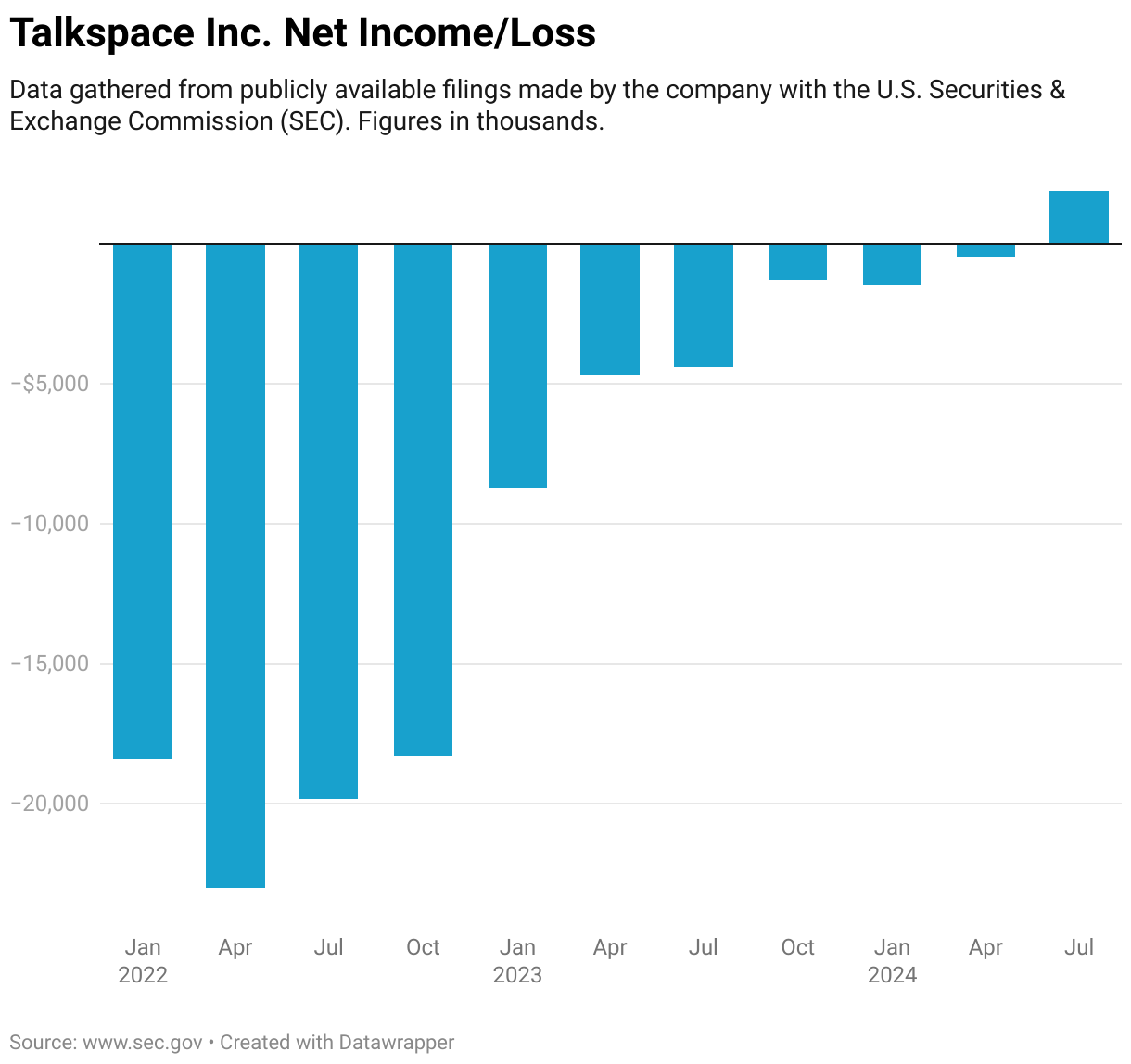Talkspace Inc. (Nasdaq: TALK) is now profitable on an unadjusted basis, a notable milestone for a company that has nearly completely transformed its focus.
The payer- and enterprise-focused digital mental health provider posted a net income of $1.87 million in the third quarter of 2024, a more than $6 million turn of fortunes compared to the losses posted in the same quarter last year.
On a more generous adjusted basis, its earnings totaled $2.35 million.
Talkspace is reaping the fruit of a massive pivot from a direct-to-consumer, cash-pay text therapy company to a largely in-network virtual provider of talk therapy, psychiatry and digital tools for enterprises that it started at the end of 2021.
“We’ve earned the respect of the payers through research that proves the efficacy of our methods and defines best practices in virtual care, and they trust us to connect their members with highly qualified, vetted mental health providers without delay,” Talkspace CEO Jon Cohen said during the company’s third-quarter earnings call Tuesday.
The payer- and direct-to-enterprise arm focuses on generating as many covered lives as possible. Each translates to a potential patient that Talkspace can serve with its therapy, psychiatry and digital services. As of the call, Cohen said that Talkspace is in-network for or otherwise accessible through a partner organization for 160 million people, up 40% compared to the same period last year.
As the company continues to spin up deals with its latest target partners — American military and Medicare entities — Talkspace could be available to as many as 200 million people in 2025, about two-thirds of the U.S. insured population, Cohen said.
“Our priority is to unlock the potential of this enormous opportunity by focusing our efforts to, first, increase the number of people who recognize and try talk space as their therapy option, and, second, keep them engaged and on the platform for subsequent sessions under our providers care to improve their long-term outcomes,” Cohen said.
Talkspace will accomplish those two objectives by optimizing marketing efforts, making improvements to the patient and provider experience through its tech platform and increasing outside referrals.

On the latter point, Talkspace has partnered with several organizations that could lead to more people seeking digital mental health services.
In September, it announced a partnership with Amazon Health Services to be a part of the Conditions program. The partnership is meant to help Amazon users who may need mental health services land at Talkspace’s in-network eligibility checker. Also during the quarter, Talkspace also announced partnerships with BeMe, PM Pediatric Care, the Tennis Players Association and Wellbeing at Work.
Its latest partnership reflects the progress of one Talkspace’s major focus areas of the year. On Oct. 23, the company announced a partnership with the AI-powered social health and peer support platform Wisdo Health, which is tailored to those 65 years and older.
Cohen said near the start of the year that it would make serving those insured by Medicare and the privately administered equivalent, Medicare Advantage, a reality in 2024. Behavioral Health Business reported in June 2022 that Medicare would be a part of Talkspace’s future business. Now, the company is approved by the federal government to offer its service to seniors on Medicare in 40 states; it is live in 30, including Texas, Florida, California and New York.
It announced that it was in-network with UnitedHealthcare Medicare Advantage Plans, its first such deals, at the beginning of the month. The deal makes Talkspace available to about 7 million members, Cohen said.
It also announced it is now in network with TRICARE East, administered by Humana Military, increasing potential access to about 6 million American service members and their family members.
Here’s a breakdown of other key metrics that reflect the company’s growth over the quarter:
— Payer revenue: $32 million, up 45%
— Direct to enterprise revenue: $9.37 million, up 17%
— D2C revenue: $5.99 million, down 30%
— Eligible lives covered: 158.1 million, up 40%
— Payer sessions complete: 316,400, up 38%
— Active consumer members: 8,600, down 35%
Cohen pushed back on the notion that the company was “cannibalizing” its consumer segment. Rather, more potential patients were accessing Talkspace through their health plan or through an enterprise partnership. Even then, about half of new patients engaging with Talkspace are new to therapy, showing an expansion of its patient base.
Still, Cohen noted that, for whatever reason, people will choose to pay out of pocket for the company’s services. He speculated that this might be because of high deductibles or fear of stigma by employers.
“There will always be a consumer business; I can’t tell you what that percentage will be in the end, but it’ll always remain as a piece of the business,” Cohen said.
William Blair analyst Ryan Daniels said in a note that the company’s financial performance and several growth initiatives give Talkspace a favorable trajectory.
“We continue to view Talkspace as a solid growth investment despite the recent weakness seen in the B2C segment, as we believe the virtual behavioral health market is set for material growth over the coming years and we like the company’s focus on the B2B space,” the note states.
